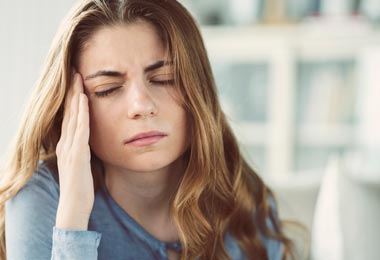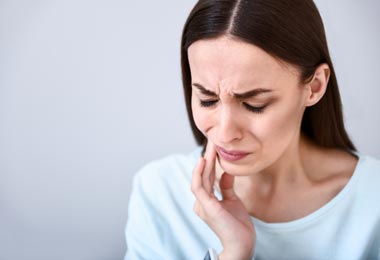Headaches in Children
What is a headache?
A headache is pain or discomfort in the head or face area. Headaches can be single or recurrent in nature, and localized to one or more areas of the head and face.
What causes a headache?
The exact cause of headaches is not completely understood. It is thought that many headaches are the result of tight muscles and dilated, or expanded, blood vessels in the head. Although migraine headaches were previously thought to be due to dilated blood vessels in the brain, newer theories suggest that changes in brain chemicals or electrical signaling may be involved. Other headaches may be caused by an alteration in the communication between parts of the nervous system that relay information about pain, coming from the area of the head, face, and neck. Lack of sleep and poor sleep quality are often the cause of chronic headaches. Occasionally, there is an actual problem in the brain, such as a tumor or malformation of the brain, although this is rare.
The way a child exhibits a headache may be related to many factors, such as genetics, hormones, stress, diet, medications, and dehydration. Recurrent headaches of any type can cause school problems, behavioral problems, and/or depression.
What are the different types of headaches?
There are many different ways to classify headaches. One method divides headaches into two categories:
Primary headaches
These are usually caused by tight muscles, dilated blood vessels, alterations in communication between parts of the nervous system, or inflammation of the structures in the brain and are not linked to another medical condition. Types of primary headaches include the following:
Migraines
Migraines may start early in childhood. It is estimated that nearly 20 percent of teens experience migraine headache. The average age of onset is 7 years of age for boys and 10 years of age for girls. There is often a family history of migraines. Some females may have migraines that correlate with their menstrual periods. While every child may experience symptoms differently, the following are the most common symptoms of a migraine:
-
Pain on one or both sides of the head (some younger children may complain of pain all over)
-
Pain may be throbbing or pounding in quality (although young children may not be able to describe their pain)
-
Sensitivity to light or sound
-
Nausea and/or vomiting
-
Abdominal discomfort
-
Sweating
-
Child may become quiet or pale
-
Some children have an aura before the migraine, such as a sense of flashing lights, a change in vision, or funny smells
Tension headaches
Tension headaches are the most common type of headache. Stress and mental or emotional conflict are often factors in triggering pain related to tension headaches. While every child may experience symptoms differently, the following are the most common symptoms of a tension headache:
-
Slow onset of the headache
-
Head usually hurts on both sides
-
Pain is dull or feels like a band around the head
-
Pain may involve the posterior (back) part of the head or neck
-
Pain is mild to moderate, but not severe
-
Change in the child's sleep habits
-
Children with tension headaches typically do not experience nausea, vomiting, or light sensitivity.
Cluster headaches
Cluster headaches usually start in children older than 10 years of age, and are more common in adolescent males. They are much less frequent than migraine or tension headaches. Cluster headaches usually occur in a series that may last weeks or months, and this series of headaches may return every year or two. While every child may experience symptoms differently, the following are the most common symptoms of a cluster headache:
-
Severe pain on one side of the head, usually behind one eye
-
The eye that is affected may have a droopy lid, small pupil, or redness and swelling of the eyelid
-
Runny nose or congestion
-
Swelling of the forehead
Secondary headaches
These are from an organic cause in the brain (problems in the structure of the brain) due to another health condition or disease, and are the least common type of headaches.
What types of headache are associated with serious illness?
The child may have varying degrees of symptoms associated with the severity of the headache depending on the type of headache. Some headaches may be more serious. Symptoms that may suggest a more serious underlying cause of the headache may include the following:
-
A very young child with a headache
-
A child that is awakened by the pain of a headache
-
Headaches that start very early in the morning
-
Pain that is worsened by strain, such as a cough or a sneeze
-
Recurrent episodes of vomiting without nausea or other signs of a stomach virus
-
Sudden onset of pain and the "worst headache" ever
-
Headache that is becoming more severe or continuous
-
Personality changes that have occurred as the headache syndrome evolved
-
Changes in vision
-
Weakness in the arms or legs, or balance problems
The symptoms of a headache may resemble other conditions or medical problems. Always consult your child's doctor for a diagnosis.
How are headaches diagnosed?
The full extent of the problem may not be completely understood immediately, but may be revealed with a comprehensive medical evaluation and diagnostic testing. The diagnosis of a headache is made with a careful history and physical examination and diagnostic tests. During the examination, the doctor obtains a complete medical history of the child and family.
Questions commonly asked during the examination may include the following:
-
When do headaches occurs?
-
What is the location of the headache?
-
What do the headaches feel like?
-
How long do the headaches last?
-
Have there been changes in walking and behavior patterns, or personality?
-
Do changes in positioning or sitting-up cause the headache?
-
Is your child having trouble sleeping?
-
Does your child have a history of emotional stress?
-
Is there a history of trauma to your child's head or face?
If the history is consistent with migraine or tension type headaches and the neurological exam is normal, no further diagnostic testing may be necessary.
Other diagnostic tests may include:
-
Blood tests. These may include a complete blood count, levels or iron, levels of ferritin, and thyroid function tests.
-
MRI. A diagnostic procedure that uses a combination of large magnets, radiofrequencies, and a computer to produce detailed images of organs and structures within the body.
-
CT scan. A diagnostic imaging procedure that uses a combination of X-rays and computer technology to produce horizontal, or axial, images (often called slices) of the body. A CT scan shows detailed images of any part of the body, including the bones, muscles, fat, and organs. CT scans are more detailed than general X-rays.
-
Polysomnogram. This is a painless test that is usually done in a sleep lab. It involves recording breathing and muscle movements. A polysomnogram is generally done if there is a suggestion of a sleep disorder, such as sleep apnea or another sleep related problem.
Treatment for headaches
Specific treatment for headaches will be determined by your child's doctor based on:
-
Your child's age, overall health, and medical history
-
Extent of the headaches
-
Type of headaches
-
Your child's tolerance for specific medications, procedures, or therapies
-
Your opinion or preference
The ultimate goal of treatment is to stop the headache from occurring. Medical management relies on the proper identification of the type of headache and may include:
-
Rest in a quiet, dark environment
-
Medications, as recommended by your child's doctor
-
Stress management
-
Avoid known triggers, such as certain foods and beverages, lack of sleep, and fasting
-
Diet changes
-
Exercise
Migraine headaches may require specific medication management including:
-
Abortive medicines. Medicines, prescribed by your child's doctor, that act on specific receptors in blood vessels in the head and can stop a headache in progress.
-
Rescue medicines. Medicines purchased over-the-counter, such as analgesics (pain relievers), to stop the headache.
-
Preventive medicines. Medicines, prescribed by your child's doctor, that are taken daily to reduce the onset of severe migraine headaches.
Some headaches may require immediate medical attention including hospitalization for observation, diagnostic testing, or even surgery. Treatment is individualized depending on the extent of the underlying condition that is causing the child's headache. The extent of the child's recovery is individualized depending on the type of headache and other medical problems that may be present.




